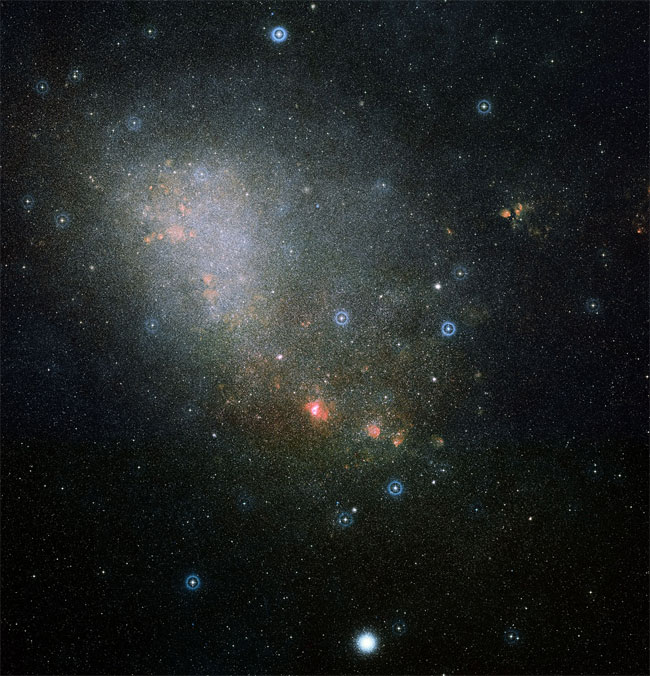
Astronomy is a science of observation. Unlike biologists or chemists, astronomers can't manipulate the objects they study. And against a night sky whose stellar inhabitants all appear identical, gauging even simple things about a star, such as its distance and brightness, is difficult.
That is why astronomers turn to stellar clusters, gravity-bound collections of stars all created at roughly the same time and from the same material. Such clusters are the closest thing astronomers have to a controlled laboratory environment.
"All the stars in a cluster are the same distance away, so you can compare brightness without having to worry about whether a star that appears faint is actually very bright but just far away," said Carlton Pryor, a star cluster expert at Rutgers University in New Jersey.
Open and globular
Astronomers recognize two basic types of star clusters: globular and open. Globular clusters are tight spherical bundles made up of hundreds of thousands of old stars born in the early years of our galaxy's formation. In contrast, open star clusters are irregularly shaped and composed of younger, more loosely packed collections of stars.
The Hubble Space Telescope recently snapped the most detailed images to date of NGC 265 and NGC 290, two open star clusters located 200,000 light-years away in the Small Magellanic Cloud, a dwarf galaxy that orbits our own Milky Way. [Astronomers also produced videos that zoom in on NGC 265 and NGC 290.]
The images show loosely knit gatherings of stars ranging in color from blue to red. While pretty to look at, the colors are important clues to astronomers about the mass distribution of stars in the cluster. Blue stars are massive and very hot, while orange to reddish stars are smaller and cooler.
Breaking space news, the latest updates on rocket launches, skywatching events and more!
Globular clusters, in contrast, tend to be less motley and are consist mainly of dead or very ancient stars, some only a few hundred million years younger than the universe itself, which is pegged at about 13.7 billion years. Their stars also tend to be smaller, since all of the large stars have either exploded as supernova or shriveled into white dwarfs. Globular clusters also have high concentrations of red dwarfs, small, dim stars that can burn for billions of years.
Importance to astronomy
Star clusters have proven crucial to uncovering the secrets of stellar evolution and for answering basic questions about how galaxies form and even when the universe began.

"If you want to see how people grow, you can either watch a person for a lifetime or you can look at different populations of people-from babies to old people-and compare them," Pryor explained.
Because the lifetime of a star can be billions of years, astronomers must use the second approach. They observe star clusters of different ages, from ancient globular clusters to newly-formed open clusters, as well as everything in between, and then compare them.
Using this method, researchers can get an idea of what the rate of star formation was like during different stages of our galaxy's evolution and what its chemical composition was at different time points.
"Globular clusters are fairly metal-poor, while the open clusters are relatively metal-rich," said Soeren from Larson Utrecht University in the Netherlands, who was involved in analyzing the new Hubble images. "This is consistent with the idea that global clusters formed very early on."
During the early phases of our galaxy's development, the most abundent chemical elements were hydrogen and helium. As stars ignited and burned, they produced heavier metal elements, which were incorporated into later generations of stars.
In our place
Star clusters also gave astronomers the first hints that our solar system was not located at the center of the Milky Way, as was commonly thought until the 1930s, but actually farther out, near the edge.
One of the first indications of this was the observation that globular clusters weren't evenly distributed across the night sky.
"If you plot the distribution of clusters, you discover that almost all of them are on one side of the sky, concentrated in the constellation Sagittarius in the summer sky," Pryor explained.
If our Sun was indeed located centrally within the Milky Way, globular clusters should be more evenly distributed in the sky since they are most commonly found orbiting the centers of galaxies.
Globular clusters were also an early tip-off to astronomers that their estimates of the age of the universe were off.
Calculations based on early estimates of the Hubble Constant suggested the universe was only about 10 billion years old, but some globular clusters appeared to be between 12 to 15 billion years old.
"Globular clusters are old and give us a limit on the age of the universe," Pryor said. "The universe couldn't be younger than the oldest star cluster."
- Hubble Unveils Double Star Cluster in Nearby Galaxy
- The Milky Way Galaxy Shreds a Star Cluster
- Recount Results: A Million Stars Missing
- Earliest-Ever Baby Pics of Star Nurseries Found, Astronomers Say
Ker Than is a science writer and children's book author who joined Space.com as a Staff Writer from 2005 to 2007. Ker covered astronomy and human spaceflight while at Space.com, including space shuttle launches, and has authored three science books for kids about earthquakes, stars and black holes. Ker's work has also appeared in National Geographic, Nature News, New Scientist and Sky & Telescope, among others. He earned a bachelor's degree in biology from UC Irvine and a master's degree in science journalism from New York University. Ker is currently the Director of Science Communications at Stanford University.
